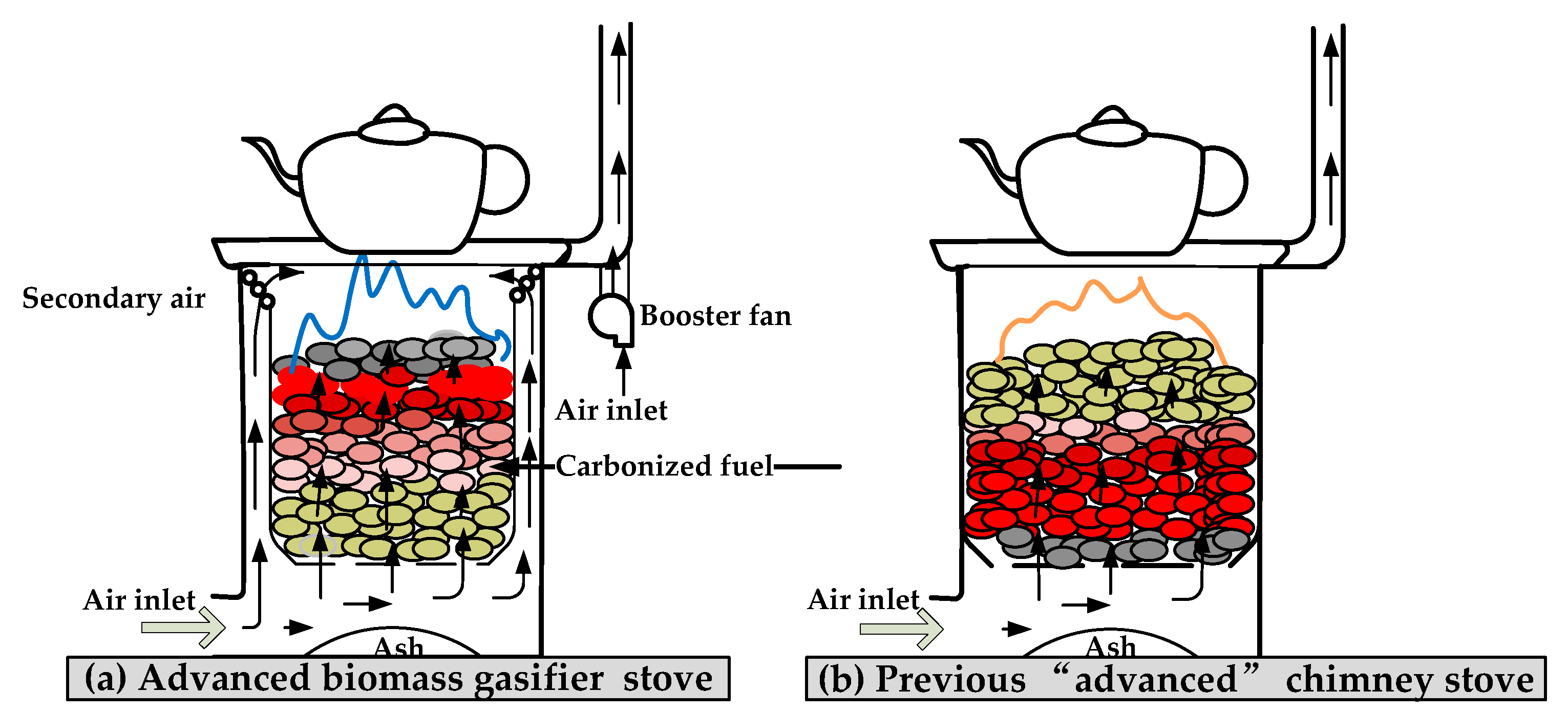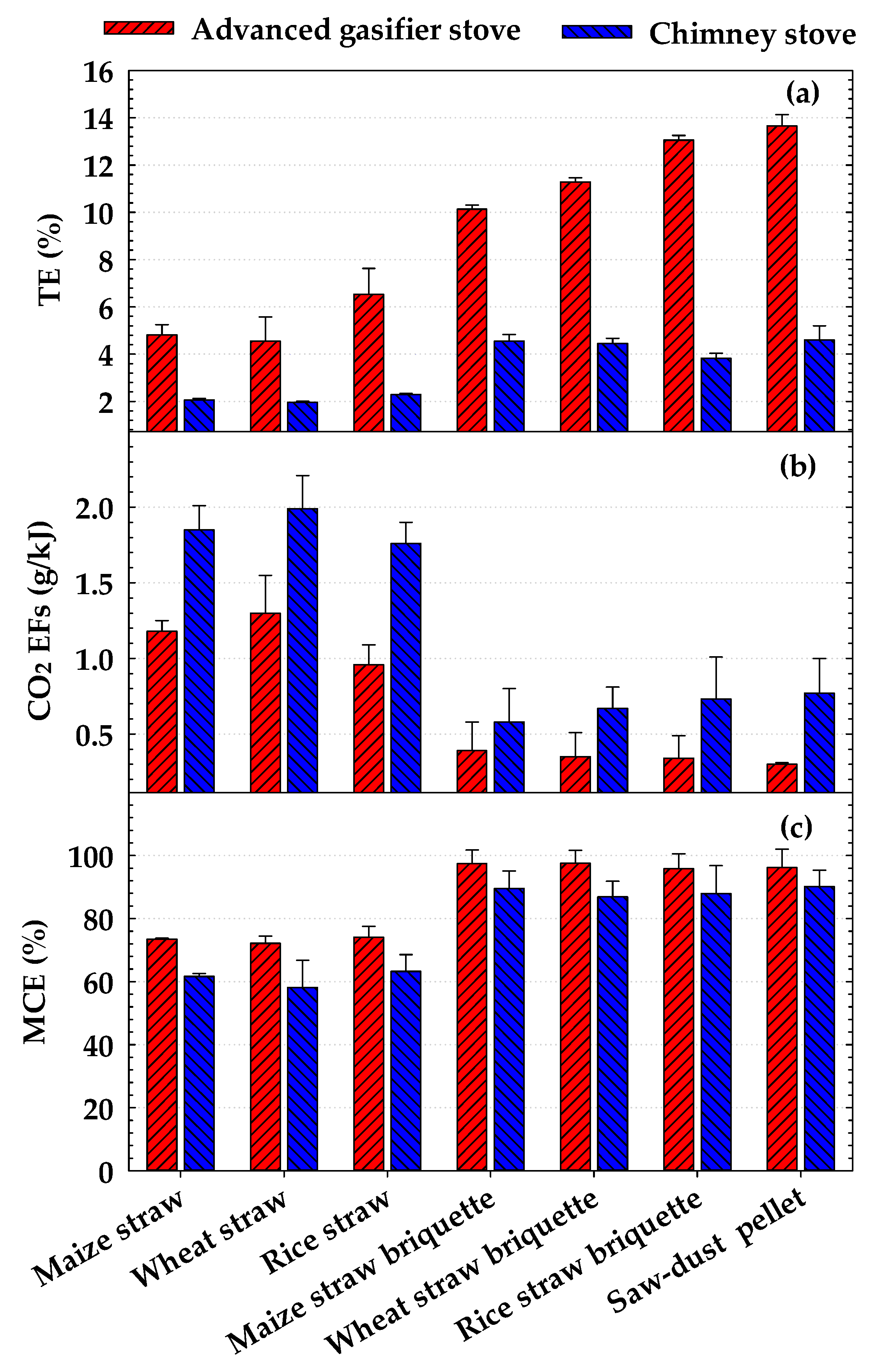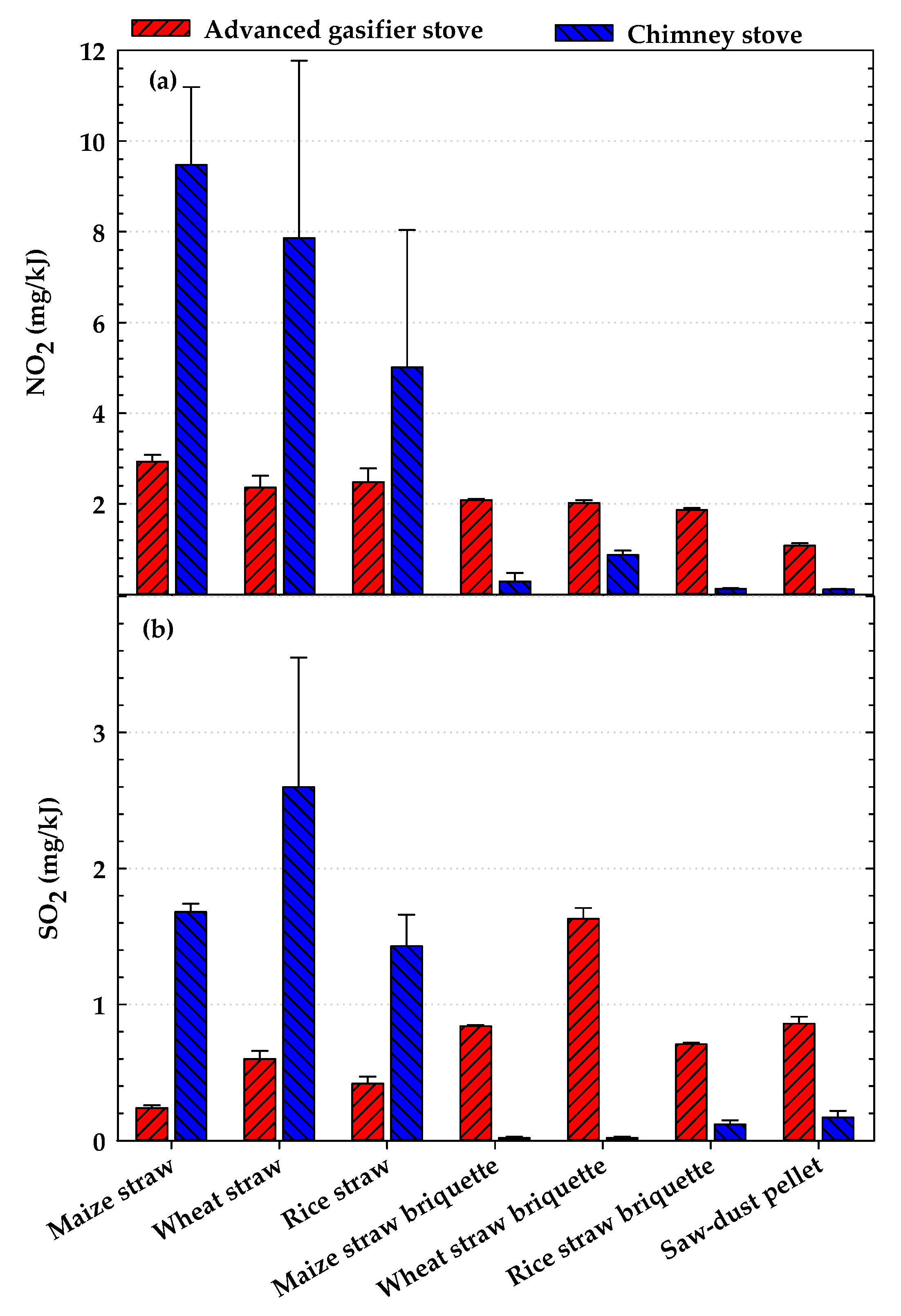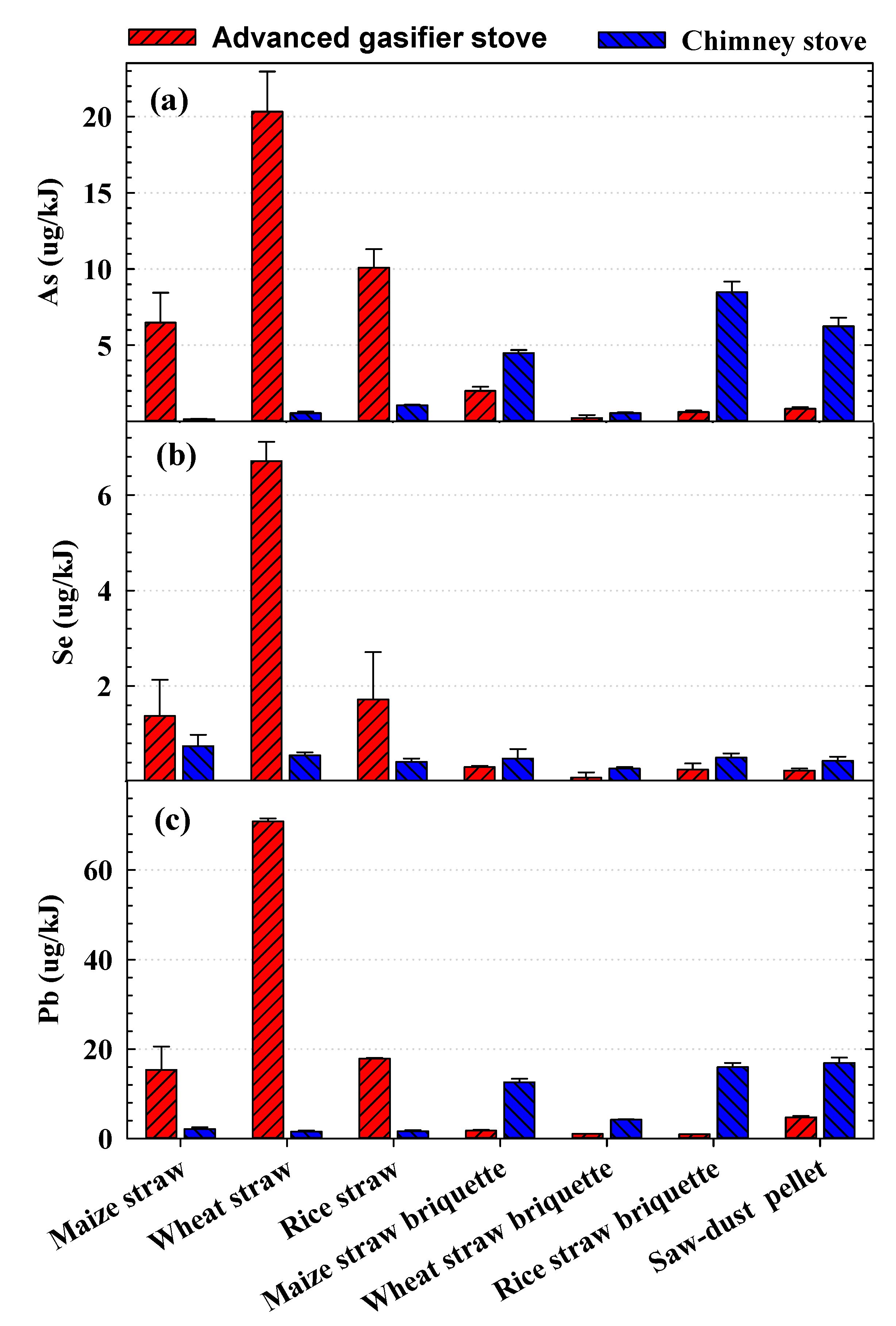Improving Combustion Technology for Cooking Activities for Pollutant Emission Reduction and Carbon Neutrality
Abstract
:1. Introduction
2. Materials and Methods
2.1. Solid Fuel Samples
2.2. Tested Stove and Combustion Technologies
2.3. Test Procedure
2.4. Analysis Methods
3. Results
3.1. CO2 Emmisions, MCE, and TE
3.2. Emissions of PM, NOx, SO2, and Three Toxic Elements
4. Discussion
5. Conclusions
Supplementary Materials
Author Contributions
Funding
Institutional Review Board Statement
Informed Consent Statement
Data Availability Statement
Acknowledgments
Conflicts of Interest
References
- Mccarron, A.; Uny, I.; Caes, L.; Lucas, S.E.; Price, H. Solid fuel users’ perceptions of household solid fuel use in low- and middle-income countries: A scoping review. Environ. Int. 2020, 143, 105991. [Google Scholar] [CrossRef] [PubMed]
- IEA. Tracking SDG7: The Energy Progress Report; IEA: Paris, France, 2021; Available online: https://www.iea.org/reports/tracking-sdg7-the-energy-progress-report-2021 (accessed on 1 January 2022).
- Meng, W.; Shen, G.; Shen, H.; Chen, Y.; Yun, X.; Li, J.; Ma, J.; Liu, J.; Cheng, H.; Hu, J.; et al. Synergistic Health Benefits of Household Stove Upgrading and Energy Switching in Rural China. Environ. Sci. Technol. 2021, 55, 14567–14575. [Google Scholar] [CrossRef] [PubMed]
- Ivanova, D.; Stadler, K.; Steen-Olsen, K.; Wood, R.; Vita, G.; Tukker, A.; Hertwich, E.G. Environmental Impact Assessment of Household Consumption. J. Ind. Ecol. 2016, 20, 526–536. [Google Scholar] [CrossRef]
- IEA. CO2 Emissions by Energy Source, World 1990–2019; IEA: Paris, France, 2021; Available online: https://www.iea.org/data-and-statistics/data-browser (accessed on 1 January 2022).
- Sun, W.; Huang, C. Predictions of carbon emission intensity based on factor analysis and an improved extreme learning machine from the perspective of carbon emission efficiency. J. Clean. Prod. 2022, 338, 130414. [Google Scholar] [CrossRef]
- Liu, L.-C.; Wu, G.; Wang, J.-N.; Wei, Y.-M. China’s carbon emissions from urban and rural households during 1992–2007. J. Clean. Prod. 2011, 19, 1754–1762. [Google Scholar] [CrossRef]
- Nwachukwu, C.M.; Wang, C.; Wetterlund, E. Exploring the role of forest biomass in abating fossil CO2 emissions in the iron and steel industry—The case of Sweden. Appl. Energy 2021, 288, 116558. [Google Scholar] [CrossRef]
- Popp, J.; Kovács, S.; Oláh, J.; Divéki, Z.; Balázs, E. Bioeconomy: Biomass and biomass-based energy supply and demand. New Biotechnol. 2021, 60, 76–84. [Google Scholar] [CrossRef]
- Kang, Y.; Yang, Q.; Bartocci, P.; Wei, H.; Chen, H. Bioenergy in China: Evaluation of domestic biomass resources and the associated greenhouse gas mitigation potentials. Renew. Sustain. Energy Rev. 2020, 127, 109842. [Google Scholar] [CrossRef]
- Du, W.; Yun, X.; Chen, Y.; Zhong, Q.; Wang, W.; Wang, L.; Qi, M.; Shen, G.; Tao, S. PAHs emissions from residential biomass burning in real-world cooking stoves in rural China. Environ. Pollut. 2020, 267, 115592. [Google Scholar] [CrossRef]
- Tao, S.; Ru, M.Y.; Du, W.; Zhu, X.; Zhong, Q.R.; Li, B.G.; Shen, G.F.; Pan, X.L.; Meng, W.J.; Chen, Y.L.; et al. Quantifying the rural residential energy transition in China from 1992 to 2012 through a representative national survey. Nat. Energy 2018, 3, 567–573. [Google Scholar] [CrossRef]
- Yuan, R.; Rodrigues, J.F.D.; Wang, J.; Tukker, A.; Behrens, P. A global overview of developments of urban and rural household GHG footprints from 2005 to 2015. Sci. Total Environ. 2022, 806, 150695. [Google Scholar] [CrossRef] [PubMed]
- Hu, W.; Downward, G.S.; Reiss, B.; Xu, J.; Bassig, B.A.; Hosgood, H.D.; Zhang, L.L.; Seow, W.J.; Wu, G.P.; Chapman, R.S.; et al. Personal and Indoor PM2.5 Exposure from Burning Solid Fuels in Vented and Unvented Stoves in a Rural Region of China with a High Incidence of Lung Cancer. Environ. Sci. Technol. 2014, 48, 8456–8464. [Google Scholar] [CrossRef] [PubMed] [Green Version]
- Alnes, L.W.H.; Mestl, H.E.S.; Berger, J.; Zhang, H.; Wang, S.; Dong, Z.; Ma, L.; Hu, Y.; Zhang, W.; Aunan, K. Indoor PM and CO concentrations in rural Guizhou, China. Energy Sustain. Dev. 2014, 21, 51–59. [Google Scholar] [CrossRef]
- Wu, D.; Qi, J.; Li, Q.; Chen, J.; Chen, J. Extreme Exposure Levels of PCDD/Fs Inhaled from Biomass Burning Activity for Cooking in Typical Rural Households. Environ. Sci. Technol. 2021, 55, 7299–7306. [Google Scholar] [CrossRef] [PubMed]
- Wu, D.; Zheng, H.; Li, Q.; Jin, L.; Lyu, R.; Ding, X.; Huo, Y.; Zhao, B.; Jiang, J.; Chen, J.; et al. Toxic potency-adjusted control of air pollution for solid fuel combustion. Nat. Energy 2022, 7, 194–202. [Google Scholar] [CrossRef]
- Sun, J.; Shen, Z.; Zhang, B.; Zhang, L.; Zhang, Y.; Zhang, Q.; Wang, D.; Huang, Y.; Liu, S.; Cao, J. Chemical source profiles of particulate matter and gases emitted from solid fuels for residential cooking and heating scenarios in Qinghai-Tibetan Plateau. Environ. Pollut. 2021, 285, 117503. [Google Scholar] [CrossRef] [PubMed]
- Feng, R.; Zhou, R.; Shi, W.; Shi, N.; Fang, X. Exploring the spatial heterogeneity and temporal homogeneity of ambient PM10 in nine core cities of China. Sci. Rep. UK 2021, 11, 8991. [Google Scholar] [CrossRef]
- Du, W.; Yun, X.; Fu, N.; Qi, M.; Wang, W.; Wang, L.; Chen, Y.; Shen, G. Variation of indoor and outdoor carbonaceous aerosols in rural homes with strong internal solid fuel combustion sources. Atmos. Pollut. Res. 2020, 11, 992–999. [Google Scholar] [CrossRef]
- Shen, G.; Ru, M.; Du, W.; Zhu, X.; Zhong, Q.; Chen, Y.; Shen, H.; Yun, X.; Meng, W.; Liu, J.; et al. Impacts of air pollutants from rural Chinese households under the rapid residential energy transition. Nat. Commun. 2019, 10, 3405. [Google Scholar] [CrossRef] [Green Version]
- Shen, H.; Tao, S.; Chen, Y.; Ciais, P.; Güneralp, B.; Ru, M.; Zhong, Q.; Yun, X.; Zhu, X.; Huang, T.; et al. Urbanization-induced population migration has reduced ambient PM 2.5 concentrations in China. Sci. Adv. 2017, 3, e1700300. [Google Scholar] [CrossRef] [Green Version]
- Qi, J.; Wu, J.; Zhang, L. Influence of Molding Technology on Thermal Efficiencies and Pollutant Emissions from Household Solid Fuel Combustion during Cooking Activities in Chinese Rural Areas. Symmetry 2021, 13, 2223. [Google Scholar] [CrossRef]
- Zhang, C.; Liu, C.; Li, X.; Liu, P.; Zhang, Y.; Du, Q.; Liu, J.; Zhuo, W.; Zhuo, Y.; Yang, J.; et al. A novel clean combustion technology for solid fuels to efficiently reduce gaseous and particulate emissions. J. Clean. Prod. 2021, 320, 128864. [Google Scholar] [CrossRef]
- Qi, J.; Li, H.; Wang, Q.; Han, K. Combustion Characteristics, Kinetics, SO2 and NO Release of Low-Grade Biomass Materials and Briquettes. Energies 2021, 14, 2655. [Google Scholar] [CrossRef]
- Qi, J.; Li, Q.; Wu, J.; Jiang, J.; Miao, Z.; Li, D. Biocoal Briquettes Combusted in a Household Cooking Stove: Improved Thermal Efficiencies and Reduced Pollutant Emissions. Environ. Sci. Technol. 2017, 51, 1886–1892. [Google Scholar] [CrossRef] [PubMed]
- Champion, W.M.; Warren, S.H.; Kooter, I.M.; Preston, W.; Krantz, Q.T.; DeMarini, D.M.; Jetter, J.J. Mutagenicity- and pollutant-emission factors of pellet-fueled gasifier cookstoves: Comparison with other combustion sources. Sci. Total. Environ. 2020, 739, 139488. [Google Scholar] [CrossRef]
- Dafnomilis, I.; Hoefnagels, R.; Pratama, Y.W.; Schott, D.L.; Lodewijks, G.; Junginger, M. Review of solid and liquid biofuel demand and supply in Northwest Europe towards 2030—A comparison of national and regional projections. Renew. Sustain. Energy Rev. 2017, 78, 31–45. [Google Scholar] [CrossRef] [Green Version]
- Shen, G.; Wei, S.; Zhang, Y.; Wang, R.; Wang, B.; Li, W.; Shen, H.; Huang, Y.; Chen, Y.; Chen, H.; et al. Emission of oxygenated polycyclic aromatic hydrocarbons from biomass pellet burning in a modern burner for cooking in China. Atmos. Environ. 2012, 60, 234–237. [Google Scholar] [CrossRef] [Green Version]
- Horvat, I.; Dović, D.; Filipović, P. Numerical and experimental methods in development of the novel biomass combustion system concept for wood and agro pellets. Energy 2021, 231, 120929. [Google Scholar] [CrossRef]
- Castro, C.; Fraga, L.; Ferreira, E.; Martins, J.; Ribeiro, P.; Teixeira, J.C. Experimental Studies on Wood Pellets Combustion in a Fixed Bed Combustor Using Taguchi Method. Fuels 2021, 2, 376–392. [Google Scholar] [CrossRef]
- Arora, P.; Jain, S. A review of chronological development in cookstove assessment methods: Challenges and way forward. Renew. Sustain. Energy Rev. 2016, 55, 203–220. [Google Scholar] [CrossRef]
- Ochieng, C.; Vardoulakis, S.; Tonne, C. Household air pollution following replacement of traditional open fire with an improved rocket type cookstove. Sci. Total Environ. 2017, 580, 440–447. [Google Scholar] [CrossRef] [PubMed]
- Chakraborty, D.; Mondal, N.K. Reduction in household air pollution and associated health risk: A pilot study with an improved cookstove in rural households. Clean Technol. Environ. Policy 2021, 23, 1993–2009. [Google Scholar] [CrossRef]
- Stanistreet, D.; Phillip, E.; Kumar, N.; Anderson de Cuevas, R.; Davis, M.; Langevin, J.; Jumbe, V.; Walsh, A.; Jewitt, S.; Clifford, M. Which Biomass Stove(s) Capable of Reducing Household Air Pollution Are Available to the Poorest Communities Globally? Int. J. Environ. Res. Public Health 2021, 18, 9226. [Google Scholar] [CrossRef] [PubMed]
- Kirch, T.; Medwell, P.R.; Birzer, C.H.; Eyk, P. Feedstock Dependence of Emissions from a Reverse-Downdraft Gasifier Cookstove. Energy Sustain. Dev. 2020, 56, 42–50. [Google Scholar] [CrossRef]
- Njenga, M.; Iiyama, M.; Jamnadass, R.; Helander, H.; Larsson, L.; Leeuw, J.D.; Neufeldt, H.; De Nowina, K.R.; Sundberg, C. Gasifier as a cleaner cooking system in rural Kenya. J. Clean. Prod. 2016, 121, 208–217. [Google Scholar] [CrossRef]
- Bryden, K.M.; Still, D.; Scott, P.; Hoffa, G.; Ogle, D.; Bailis, R.; Goyer, K. Design Principles for Wood Burning Cook Stoves, 1st ed.; Approvecho Research Centre/Shell Foundation/Partnership for Clean Indoor Air: Cottage Grove, OR, USA; USEPA: Washington, WA, USA, 2005; p. 17. [Google Scholar]
- Maccarty, N.; Still, D.; Ogle, D. Fuel use and emissions performance of fifty cooking stoves in the laboratory and related benchmarks of performance. Energy Sustain. Dev. 2010, 14, 161–171. [Google Scholar] [CrossRef]
- Li, Q.; Jiang, J.; Qi, J.; Deng, J.; Yang, D.; Wu, J.; Duan, L.; Hao, J. Improving the Energy Efficiency of Stoves to Reduce Pollutant Emissions from Household Solid Fuel Combustion in China. Environ. Sci. Technol. Lett. 2016, 3, 369–374. [Google Scholar] [CrossRef]
- Qiu, D.X.; Gu, S.H.; Catania, P.; Huang, K. Diffusion of improved biomass stoves in China. Energy Policy 1996, 24, 463–469. [Google Scholar] [CrossRef]
- Smith, K.R.; Shuhua, G.; Kun, H.; Da Xiong, Q. One hundred million improved cookstoves in China: How was it done? World Dev. 1993, 21, 941–961. [Google Scholar] [CrossRef]
- Sinton, J.E.; Smith, K.R.; Peabody, J.W.; Yaping, L.; Xiliang, Z.; Edwards, R.; Quan, G. An assessment of programs to promote improved household stoves in China. Energy Sustain. Dev. 2004, 8, 33–52. [Google Scholar] [CrossRef]
- Carter, E.M.; Shan, M.; Yang, X.D.; Li, J.R.; Baumgartner, J. Pollutant Emissions and Energy Efficiency of Chinese Gasifier Cooking Stoves and Implications for Future Intervention Studies. Environ. Sci. Technol. 2014, 48, 6461–6467. [Google Scholar] [CrossRef] [PubMed]
- Shen, G.F.; Chen, Y.C.; Xue, C.Y.; Lin, N.; Huang, Y.; Shen, H.Z.; Wang, Y.L.; Li, T.C.; Zhang, Y.Y.; Su, S.; et al. Pollutant Emissions from Improved Coal- and Wood-Fuelled Cookstoves in Rural Households. Environ. Sci. Technol. 2015, 49, 6590–6598. [Google Scholar] [CrossRef] [PubMed]
- Shen, G.; Lin, W.; Chen, Y.; Yue, D.; Liu, Z.; Yang, C. Factors influencing the adoption and sustainable use of clean fuels and cookstoves in China -a Chinese literature review. Renew. Sustain. Energy Rev. 2015, 51, 741–750. [Google Scholar] [CrossRef]
- Winijkul, E.; Bond, T.C. Emissions from residential combustion considering end-uses and spatial constraints: Part II, emission reduction scenarios. Atmos. Environ. 2016, 124, 1–11. [Google Scholar] [CrossRef] [Green Version]
- Chen, H.; Chen, L.; Hao, G. Sex difference in the association between solid fuel use and cognitive function in rural China. Environ. Res. 2021, 195, 110820. [Google Scholar] [CrossRef]
- Shen, G.; Xue, M.; Wei, S.; Chen, Y.; Zhao, Q.; Li, B.; Wu, H.; Tao, S. Influence of fuel moisture, charge size, feeding rate and air ventilation conditions on the emissions of PM, OC, EC, parent PAHs, and their derivatives from residential wood combustion. J. Environ. Sci. 2013, 25, 1808–1816. [Google Scholar] [CrossRef]
- Li, Q.; Jiang, J.; Zhang, Q.; Zhou, W.; Cai, S.; Duan, L.; Ge, S.; Hao, J. Influences of coal size, volatile matter content, and additive on primary particulate matter emissions from household stove combustion. Fuel 2016, 182, 780–787. [Google Scholar] [CrossRef]
- Paulsen, A.D.; Kunsa, T.A.; Carpenter, A.L.; Amundsen, T.J.; Schwartz, N.R.; Harrington, J.; Reed, J.; Alcorn, B.; Gattoni, J.; Yelvington, P.E. Gaseous and particulate emissions from a chimneyless biomass cookstove equipped with a potassium catalyst. Appl. Energy 2019, 235, 369–378. [Google Scholar] [CrossRef]
- NBS. Bulletin of the Seventh National Census; National Bureau of Statistics: Beijing, China, 2021. Available online: http://www.stats.gov.cn/tjsj./tjgb/rkpcgb/ (accessed on 17 March 2022).





| Raw Material | Industrial Analysis (%) | Elemental Analysis (%) | Qnet,ar 1 (MJ/kg) | ||||||||
|---|---|---|---|---|---|---|---|---|---|---|---|
| Mar 1 | Ad 2 | Vd 2 | Vdaf 3 | FCd 2 | Cdaf 3 | Hdaf 3 | Odaf 3 | Ndaf 3 | St,d 2 | ||
| Wheat straw | 5.68 | 8.97 | 74.04 | 81.33 | 16.99 | 49.76 | 7.17 | 42.00 | 0.71 | 0.33 | 14.90 |
| Rice straw | 6.36 | 10.38 | 74.31 | 82.95 | 15.31 | 49.18 | 7.40 | 42.30 | 0.81 | 0.28 | 13.42 |
| Maize straw | 5.44 | 5.03 | 80.58 | 84.85 | 14.39 | 48.66 | 7.08 | 42.86 | 1.00 | 0.37 | 15.04 |
| Sawdust | 9.3 | 2.93 | 77.47 | 79.81 | 19.6 | 53.04 | 6.91 | 39.33 | 0.70 | 0.02 | 16.37 |
Publisher’s Note: MDPI stays neutral with regard to jurisdictional claims in published maps and institutional affiliations. |
© 2022 by the authors. Licensee MDPI, Basel, Switzerland. This article is an open access article distributed under the terms and conditions of the Creative Commons Attribution (CC BY) license (https://creativecommons.org/licenses/by/4.0/).
Share and Cite
Qi, J.; Liu, L.; Wu, J. Improving Combustion Technology for Cooking Activities for Pollutant Emission Reduction and Carbon Neutrality. Atmosphere 2022, 13, 561. https://doi.org/10.3390/atmos13040561
Qi J, Liu L, Wu J. Improving Combustion Technology for Cooking Activities for Pollutant Emission Reduction and Carbon Neutrality. Atmosphere. 2022; 13(4):561. https://doi.org/10.3390/atmos13040561
Chicago/Turabian StyleQi, Juan, Lianxin Liu, and Jianjun Wu. 2022. "Improving Combustion Technology for Cooking Activities for Pollutant Emission Reduction and Carbon Neutrality" Atmosphere 13, no. 4: 561. https://doi.org/10.3390/atmos13040561






